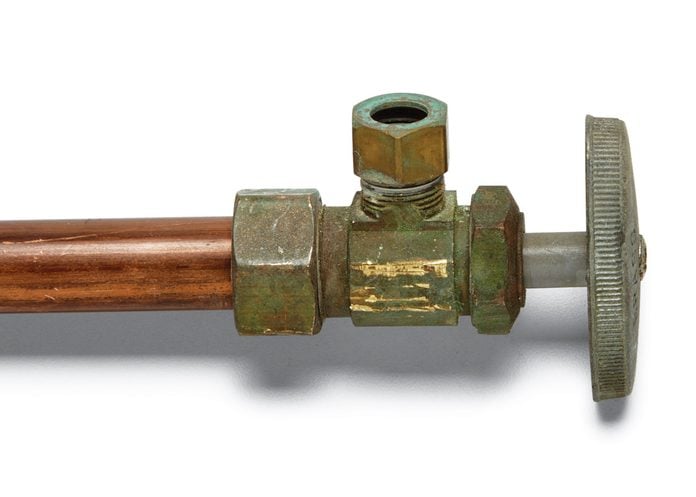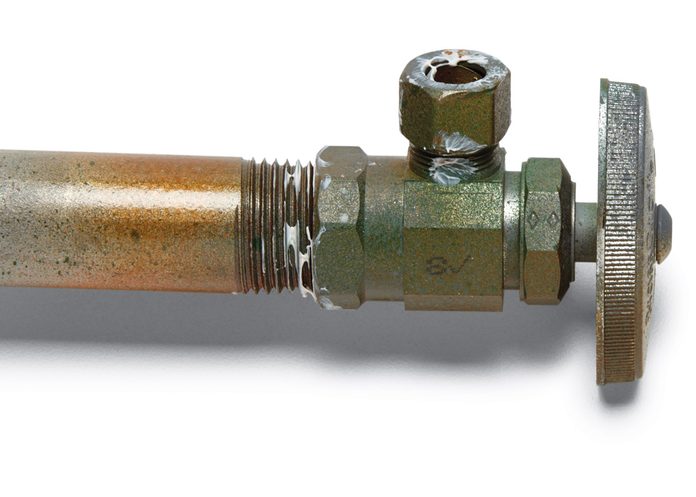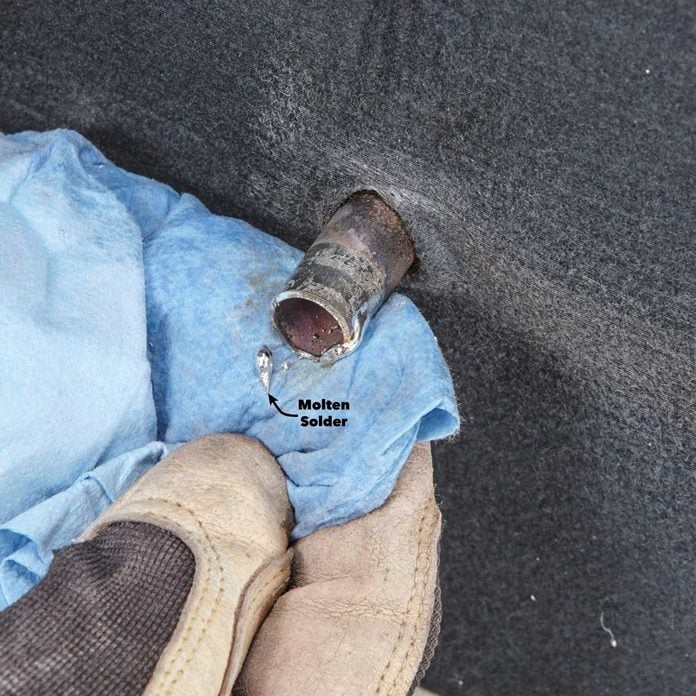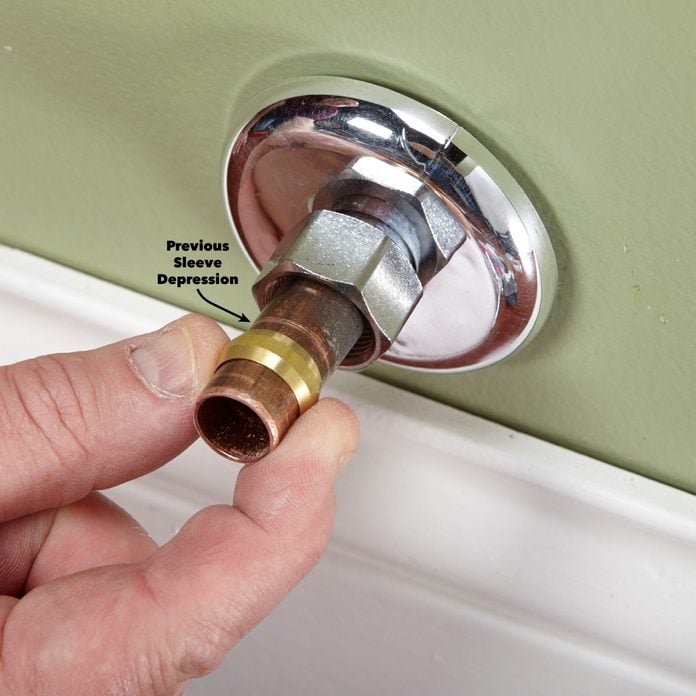How To Repair Under Sink Shutoff Valve
How to Replace a Shutoff Valve
Stop under-sink leaks with this 30-infinitesimal set.
![]() Time
Time
A full 24-hour interval
![]() Complexity
Complexity
Intermediate
![]() Price
Price
Less than $20
Introduction
Y'all can spend time rebuilding the old valve, but the problems will just reappear years from now. The best style to bargain with bad valves is to supervene upon them with modernistic quarter-plough ball valves. They rarely lock upward, leak or article of clothing out and all-time of all, they'll accept just an 60 minutes or so to install. Hither's how to put them in.
Tools Required
Materials Required
- Shutoff valve
Identify the valve connection style
A shutoff valve connects to copper plumbing pipes in ane of 2 ways:
- Pinch plumbing fixtures
- Sweat fitting.
Identify the connection blazon used in your dwelling house by referring to the photos below.
If you take an older home with galvanized pipes, we suggest hiring a plumber to exercise the switch out. Unscrewing the old valve and screwing on a new one may seem piece of cake enough. But if the piping is rusted internally or the threads are rotted, this 'elementary' plumbing job can plow into a plumbing nightmare. If your home is plumbed with PEX or plastic pipe, these instructions don't apply.
Once you lot identify the connection blazon, purchase a quarter-plough shutoff ball valve to friction match the size of the incoming copper piping and the size of the supply tube connection. If yous're replacing a sweat valve, you'll need a torch, flux, solder, emery material, wire brushes and a flame protection textile to shield the wall. This is too a expert fourth dimension to replace an old supply tube and a corroded escutcheon (wall trim plate). Pitiful to burst your bubble, but you need to stop assertive these x plumbing myths ASAP!
Projection step-past-step (12)
Step 1
Sweat Valve:

A sweat shutoff valve doesn't accept any hex flats where the copper tubing enters from the wall. Replace a sweat valve with another sweat valve or a compression valve.
Step 2
Pinch Valve:

Examine the portion of the valve closest to the wall. Look for a hexagonal compression nut and matching hex flats on the body of the valve next to the compression nut. If the valve has a compression nut but no hex flats, wait for two flats on the sides of the valve body.
Step three
Threaded Valve:

Look for threads and hex flats where the steel pipe enters the valve.
Footstep 4
Set for valve replacement
Shut off the water at the chief shutoff valve. If you have a gas water heater, turn the knob to the 'pilot' position. Close off the circuit breakers to an electric water heater. Then open a faucet on the lowest level of your house and another faucet on an upper level to drain the pipes. Then disconnect the supply tube from the shutoff valve. Replace the valve.
Step 5
After replacement
Close the new valve. Then open up the water-chief shutoff valve and let the water run until all the air is out of the pipes. Then close off the upper and lower faucets. Check the new valves for leaks. Turn the water heater gas valve back to 'on' or flip on the circuit breakers to the electric water heater.
Step 6
Remove sometime sweat valve

Hold the valve with a pliers, loosen the packing nut and unscrew the unabridged valve stalk. Peek inside and remove the old washer if it'due south stuck on the seat. Removing the valve stem allows any remaining water to drain out, making the unsweating process easier. Before you do whatever torch work, make sure in that location'southward a fire extinguisher nearby and safeguard the wall with a flame protection fabric. And then remove the old valve and the remaining solder.
To brainstorm, mantle the flame protection fabric over the copper tubing and tape it to the wall. Adjust the torch to a small-scale fame and aim it toward the body of the valve. As soon equally the solder melts, twist and pull the valve off the copper tubing with a pliers.
Step seven
Clean excess solder

Make clean the tubing with emery cloth. If you're replacing a sweat valve with a compression valve, sand off all traces of solder before adding the new escutcheon, nut and sleeve. Otherwise, remove enough one-time solder to allow the new sweat valve to slide onto the tubing. Remove the stalk and wire-brush the opening in the new quarter-turn valve and apply flux to the valve and the copper tubing.
Put on a leather glove and grab a damp cotton fiber rag (microfiber fabric will melt). With the flame protection textile in place, heat the valve just enough to draw in the solder. Heat the remaining solder with the torch until information technology's molten. As before long as the solder melts, wipe away the backlog solder with a damp rag. Be sure to wear leather gloves to prevent steam burns.
Footstep 8
Remove and replace a compression shutoff valve

To remove a pinch-style valve, hold the valve body with an adjustable or open up-end wrench, or a slip-joint pliers. Take hold of the compression nut with another wrench and turn it clockwise to loosen it. Then pull the valve off the copper tubing.
Next, remove the old compression sleeve and nut. Grab the old sleeve with a pliers, using minimal pressure to avoid distorting the copper tubing. Then rotate and pull information technology off the tubing. If the sleeve is stuck, saw it and break it.
To saw it off, apply a hacksaw to cut partially through the sleeve at an angle. Employ short strokes to avert cutting into the copper tubing. Check your progress and end cutting before you attain the copper.
Footstep 9
Twist and pause the sleeve

Insert a flat-bract screwdriver into the cut and twist the screwdriver to break the sleeve. Slide off the quondam sleeve, old pinch nut and the escutcheon (if you're going to supercede it).
Stride 10
Position the new compression sleeve

Slide the new escutcheon and pinch nut onto the copper tubing. Then, slide the new pinch sleeve onto the copper tubing. If the old sleeve left depression marks, locate the new sleeve slightly forward of the marks.
Step 11
New Compression Valve

Insert the new valve and employ a very low-cal coating of pipe dope to the pinch sleeve. Next, spiral the compression nut onto the valve until snug. Concur the valve with a wrench or a pliers and tighten the nut a one-half to three-quarters turn (follow the manufacturer's tightening instructions). Connect the supply tube and test for leaks.
Stride 12
Can you use a push-fit valve?

Several companies make quarter-turn push-fit ball-style shutoff valves that install without tools. They're a proficient culling to sweat and compression fittings if you take enough tubing projecting out from the wall and if that tubing is in good shape. They make the chore even simpler. If your stub-out tubing is perfectly symmetrical, long enough and has a square-cut end, you might exist able to use a push button-fit valve to supercede your old compression or sweat valve.
Most push-fit valves crave at least ane in. of stub-out tubing. So measure the length of the stub-out and refer to the valve manufacturer'due south length requirements before buying. If your tubing will work, shop for a valve that meets your configuration needs (direct or angled). Push-fit valves are available with and without a permanently mounted supply tube. We don't recommend the permanently installed supply tube version because you lot take to shut off the water and supplant the entire unit if the supply tube ever needs replacement.
Before installing a push-fit valve, remove any burrs from the open up cease. If you lot're replacing a sweat valve, remove all traces of solder and ensure the tubing is perfectly round. And so mark the installed length on the tubing and push the valve onto the tubing until it reaches the mark. Next fourth dimension you take a drip, clog or leak, don't crush out big bucks for a professional person plumber. You lot can fix it yourself with these 28 tips for condign a master plumber!
Originally Published: November 28, 2022
Source: https://www.familyhandyman.com/project/how-to-replace-a-shutoff-valve/
Posted by: eckerttoop1970.blogspot.com


0 Response to "How To Repair Under Sink Shutoff Valve"
Post a Comment